Performance
The accumulator is initially charged to a pressure P0 that is set at a level lower than the minimum operating pressure P1. The pressure of the gas will vary with changes in the volume, but the relationship between these parameters will depend on the amount of heat transferred to the surroundings. It is usual to assume a polytropic expansion index for the gas the value of which depends on the operating times and the duty cycle.
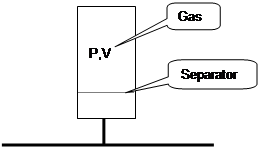
Accumulator pressure
Referring to Figure 2, the gas states are defined as:
Pre-charge: pressure P0 and volume V0.
Minimum operating: pressure P1 and volume V1.
Maximum operating: pressure P2 and volume V2.
For a gas having a mass 'm', an absolute temperature 'T' and a polytropic index 'n', the universal gas laws for a perfect gas give:
![]() (1)
(1)
![]() (2)
(2)
R = Universal gas constant
The accumulator is connected to an appropriate point in the hydraulic system such that when the pressure falls the gas will expand and deliver a volume of fluid ![]() into the hydraulic system thus maintaining its pressure. The maximum volume is given by:
into the hydraulic system thus maintaining its pressure. The maximum volume is given by:
![]() (3)
(3)
Using a polytropic index, n1, for compression from V0 to V2, for the period when the fluid pressure increases to its maximum value, equation (1) gives:
![]()
Thus ![]() (4)
(4)
Also, for the gas expansion from V2 to V1 with a polytropic index of n2:
![]() (5)
(5)
Equations 4 and 5 with equation 3 give:
 (6)
(6)
The values of the polytropic indices cannot be accurately predicted and it is usual to take the value of n1 as 1 (isothermal) and n2 as ![]() for the gas, where this value is obtained for the expected operating temperature and pressure.
for the gas, where this value is obtained for the expected operating temperature and pressure.
Thus equation 6 produces: 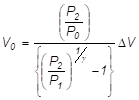 (7)
(7)
This equation gives a conservative value for most applications. In certain cases, e.g. high or low temperatures, it may be necessary to apply a correction factor and, in those situations, information should be obtained from the manufacturer.
The value for ![]() can be obtained from Figure 3 that applies to real gases and should be used in accumulator sizing calculations.
can be obtained from Figure 3 that applies to real gases and should be used in accumulator sizing calculations.
![]()
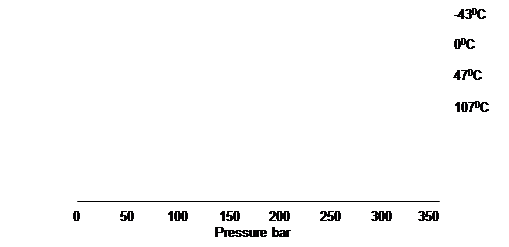
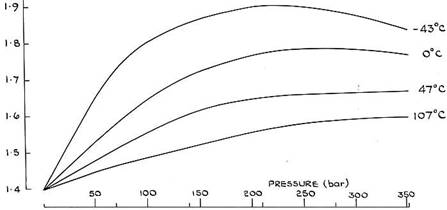
Variation in adiabatic index with pressure and temperature for nitrogen
Contamination control
Filters
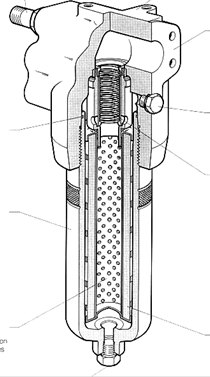
High-pressure filter (Pall)
The main features of a replaceable element high-pressure filter are shown in Figure 6. As the fluid passes radially inward through the element contaminant is trapped in the material. With time the pressure drop across the filter will increase at a rate that is dependent on the fluid condition and eventually this will cause the bypass valve to open thus passing contaminated fluid directly into the system. However, the pressure drop can be monitored either mechanically or by electronic methods and this aspect is an important feature in a properly maintained system.
The performance of a filter is based on its ability to trap particles which is defined by its beta ratio, ![]() , that is obtained from appropriate test methods.
, that is obtained from appropriate test methods.
The beta ratio is defined as:
![]()
The beta ratio is defined for particle sizes above the given level because the number of trapped particles varies with the size, which is referred to as a distribution.
![]()
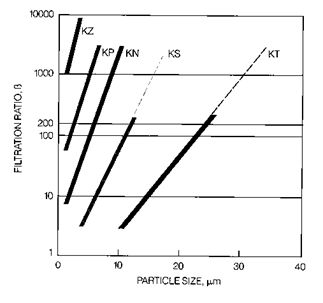
Filters are selected on the basis of achieving the desired contamination levels and having sufficient contaminant holding capacity to maintain the required contamination levels under the worst envisaged circumstances. Various selection methods are available from different filter manufacturers, the majority of which are based on an absolute filter rating at a given b ratio. Figure 7 contains an example showing the performance of different elements with a bx = 200 rating where x is the minimum particle size for a beta ratio of 200.
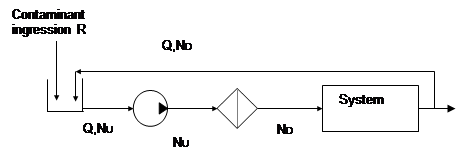
Generally it is not feasible to analyse systems in respect of the generation of contaminant particles and ingression from the environment. However a simple model such as that in Figure 8 can be used to show that:

For beta ratios in the region of 10 and above, ND reduces as the inverse proportion of the beta ratio, which is represented by the chart.
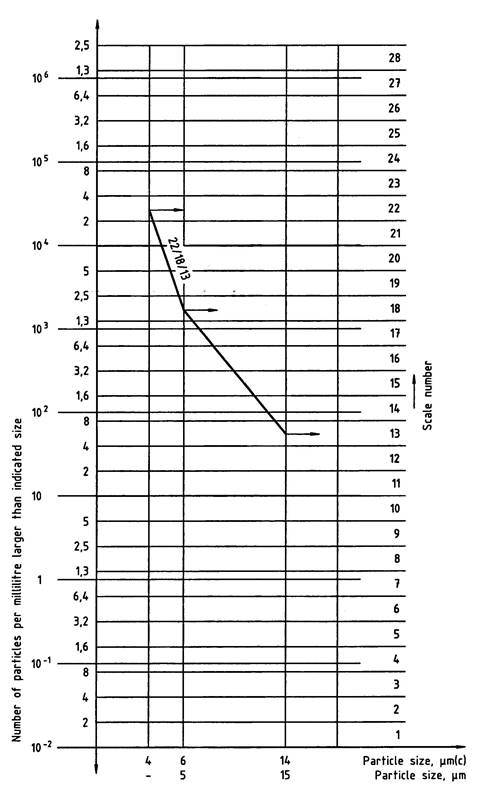
ISO 4406 standard code for contamination levels.
Thermodynamic aspects
![]()
as ![]() , then
, then ![]()
Where ![]() = Mass flow rate kg s-1
= Mass flow rate kg s-1
Cp = Specific heat 2.1 kJ kg-1 K-1 (typical value)
T = Temperature K
r = Density 870 kg m-3 (typical value)
DP = Pressure loss N m-2
Q = Flow m3s-1
Therefore, for a system with a 100 bar pressure loss, the temperature rise will be:
![]()
The input power, ![]()
![]()
where Wo is the power input given in Watts.
4.3 Cooler characteristics
![]()
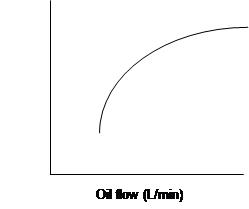
Cooler Performance Characteristics
The cooling characteristics are usually presented in the form shown in Figure 11, which will apply for a particular value of inlet temperature difference. For different values a correction factor is applied to suit the application.
If possible, the reservoir design should be such that any entrained air is released before the fluid is passed to the system inlet. A baffle can be used to increase the flow circulation and hence improve the air release. It also reduces the fluid movement due to motion of the reservoir itself.
Passing the return flow through a diffuser in the reservoir reduces the fluid velocity and, by directing the fluid away from the bottom of the reservoir, reduces the re-entrainment of solid contaminant and water from the bottom of the reservoir. Transient changes in the fluid level and the release of air require the fitment of a breather. This must contain a filter that is sized to the minimum requirements of the system. It is preferable that the fluid is filtered during topping-up or replenishing.
Source: http://www.ivt.ntnu.no/ept/fag/tep4195/innhold/Forelesninger/hydraulikknotater%20fra%20Peter/Anc%20Com%20sum%20130406.doc
Web site to visit: http://www.ivt.ntnu.no
Author of the text: indicated on the source document of the above text
If you are the author of the text above and you not agree to share your knowledge for teaching, research, scholarship (for fair use as indicated in the United States copyrigh low) please send us an e-mail and we will remove your text quickly. Fair use is a limitation and exception to the exclusive right granted by copyright law to the author of a creative work. In United States copyright law, fair use is a doctrine that permits limited use of copyrighted material without acquiring permission from the rights holders. Examples of fair use include commentary, search engines, criticism, news reporting, research, teaching, library archiving and scholarship. It provides for the legal, unlicensed citation or incorporation of copyrighted material in another author's work under a four-factor balancing test. (source: http://en.wikipedia.org/wiki/Fair_use)
The information of medicine and health contained in the site are of a general nature and purpose which is purely informative and for this reason may not replace in any case, the council of a doctor or a qualified entity legally to the profession.
The texts are the property of their respective authors and we thank them for giving us the opportunity to share for free to students, teachers and users of the Web their texts will used only for illustrative educational and scientific purposes only.
All the information in our site are given for nonprofit educational purposes